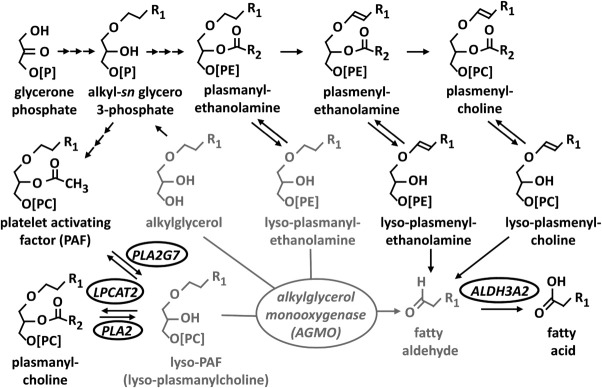FIG 2.

Simplified scheme of ether lipid metabolism and the central role of alkylglycerol monooxygenase in ether lipid degradation as suggested by its wide substrate specificity. Ether lipids are synthesized in the body in a complex set of reactions from glycerone phosphate (dihydroxyacetone phosphate). The first ether bond containing intermediate, alkyl-sn-glycero-3-phosphate, is an important branching point leading to all plasmanyl (harboring a saturated carbon side chain or one or more nonconjugated double bonds distal of the ether linkage which is connected to the sn1 position of glycerol via an ether bond) and plasmanyl (with a vinyl ether at the sn1 position of glycerol) species as well as to PAF. Lyso-PAF and lyso-plasmanyl lipids as well as alkylglycerols contained in nutrition (all drawn in red online) can then be degraded by alkylglycerol monooxygenase to a fatty aldehyde. In the so-called remodeling pathway, the PAF is synthesized via lyso PAF released from plasmanylcholine by action of a PLA2. Lyso PAF is in equilibrium with PAF by acetylation carried out by a specific acetylase (LPCAT2), and deacetylation by a specific PLA2 type enzyme (PLA2G7). By irreversible degradation of lyso-PAF, alkylglycerol monooxygenase might be capable of switching off the PAF signal (see text for details). PE stands for phosphoethanolamine, PC for phosphocholine, P for phosphate. R1 and R2 are representative lipid side chains which are saturated linear hydrocarbon chains, sometimes with one or more nonconjugated double bonds not adjacent to the ether linkage. Typical side chains have in total 16 or 18 carbon atoms. [Color figure can be viewed in the online issue, which is available at wileyonlinelibrary.com.]
